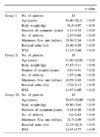Abstract
Purpose
Anticholinergics suppress the muscarinic receptors in the bladder smooth muscle and, increase the level of urine storage. Their side effects include dry mouth, dry eyes, constipation, drowsiness, and tachycardia. These adverse effects limit the dosing and often decrease patient compliance. This study examined the effect of amitryptline as one of the first-line treatments for overactive bladder patients with nocturia.
Materials and Methods
Between June 2005 and June 2006, a prospective randomized study was carried out on 45 female patients with an overactive bladder. The mean age was 57.6 years and the patients were treated with doxazosin (Group I), doxazosin with tolterodine (Group II), doxazosin with amitriptyline (Group III). All 45 (Group I: 15, Group II: 15, Group III: 15) were followed up for 4 weeks. The treatment efficacy was measured using the 3 days of voiding diaries.
Results
The actual number diurnal voids showed considerable improvement after treatment (p<0.05). However, there was no difference in treatment results between Groups II and III (p>0.05). The actual number of nightly voids improved after treatment (p<0.05), but there was no change in Group I. There was no difference between Groups II and III (p>0.05). There was no difference in the total voiding volume, functional bladder capacity, nocturnal bladder capacity index, nocturia index between pre-treatment and post-treatment in each group (p>0.05).
Figures and Tables
Fig. 1
Comparison of the nocturnal frequency between each group. Note the significant improvement in groups II and III (p=0.005, p=0.002) and the similarity between groups II and III (p=0.101). *: p=0.669, †: p=0.001, by Kruskall-Wallis test.

References
1. Wein AJ. Diagnosis and treatment of the overactive bladder. Urology. 2003. 62(5 Suppl 2):20–27.
2. Bent AE. Etiology and management of detrusor instability and mixed incontinence. Obstet Gynecol Clin North Am. 1989. 16:853–868.
3. Milsom I, Stewart W, Thuroff J. The prevalence of overactive bladder. Am J Manag Care. 2000. 6:11 Suppl. S565–S573.
4. Artibani W. Diagnosis and significance of idiopathic overactive bladder. Urology. 1997. 50(6A Suppl):31–35.
5. Blok BF, Holstege G. The central control of micturition and continence: implications for urology. BJU Int. 1999. 83:Suppl 2. 1–6.
6. Igawa Y. Discussion: functional role of M1, M2, and M3 muscarinic receptors in overactive bladder. Urology. 2000. 55(5A Suppl):47–49.
7. Fitzpatrick JM. Facts and future lines of research in lower urinary tract symptoms in men and women: an overview of the role of α1-adrenoreceptor antagonists. BJU Int. 2000. 85(Suppl 2):1–5.
8. Ouslander JG. Management of overactive bladder. N Engl J Med. 2004. 350:786–799.
9. Frewen WK. The management of urgency and frequency of micturition. Br J Urol. 1980. 52:367–369.
10. Elder DD, Stephenson TP. An assessment of the Frewen regime in the treatment of detrusor dysfunction in females. Br J Urol. 1980. 52:467–471.
11. Bo K, Berghmans LC. Nonpharmacologic treatments for overactive bladder-pelvic floor exercises. Urology. 2000. 55(5A Suppl):7–11.
12. Burgio KL, Locher JL, Goode PS, Hardin JM, McDowell BJ, Dombrowski M, et al. Behavioral vs drug treatment for urge urinary incontinence in older women: a randomized controlled trial. JAMA. 1998. 280:1995–2000.
13. Jeffcoate TN, Francis WJ. Urgency incontinence in the female. Am J Obstet Gynecol. 1966. 94:604–618.
14. Pengelly AW, Booth CM. A prospective trial of bladder training as treatment for detrusor instability. Br J Urol. 1980. 52:463–466.
15. Diokno AC, Lapides J. Oxybutynin: a new drug with analgesic and anticholinergic properties. J Urol. 1972. 108:307–309.
16. Appell RA. Clinical efficacy and safety of tolterodine in the treatment of overactive bladder: a pooled analysis. Urology. 1997. 50(6A Suppl):90–96.
17. Nilvebrant L, Hallen B, Larsson G. Tolterodine: a new bladder selective, muscarinic receptor antagonist: preclinical pharmacological and clinical data. Life Sci. 1997. 60:1129–1136.
18. Maggi CA, Borsini F, Lecci A, Giuliani S, Meli P, Gragnani L, et al. Effect of acute or chronic administration of imipramine on spinal and supraspinal micturition reflexes in rats. J Pharmacol Exp Ther. 1989. 248:278–285.
19. Gulliford G, Bidmead J. Management of incontinence. Pharm J. 2001. 267:230–232.
20. Wein AJ. Pharmacologic options for the overactive bladder. Urology. 1998. 51(2A Suppl):43–47.
21. Nygaard IE, Heit M. Stress urinary incontinence. Obstet Gynecol. 2004. 104:607–620.
22. Thor KB, Katofiasc MA. Effects of duloxetine, a combined serotonin and norepinephrine reuptake inhibitor, on central neural control of lower urinary tract function in the chloralose-anesthetized female cat. J Pharmacol Exp Ther. 1995. 274:1014–1024.
23. Sharma A, Goldberg MJ, Cerimele BJ. Pharmacokinetics and safety of duloxetine, a dual-serotonin and norepinephrine reuptake inhibitor. J Clin Pharmacol. 2000. 40:161–167.
24. Downie JW. Pharmacological manipulation of central micturition circuitry. Curr Opin CPNS Invest Drugs. 1999. 1:231–234.
25. Kakizaki H, Yoshiyama M, Koyanagi T, De Groat WC. Effects of WAY100635, a selective 5-HT1A-receptor antagonist on the micturition-reflex pathway in the rat. Am J Physiol Regul Integr Comp Physiol. 2001. 280:R1407–R1413.




 PDF
PDF ePub
ePub Citation
Citation Print
Print





 XML Download
XML Download